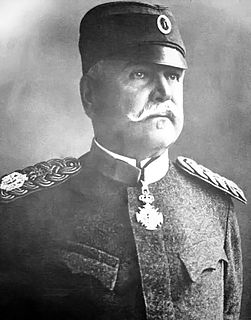
A brigade is a major tactical military formation that is typically composed of three to six battalions plus supporting elements. It is roughly equivalent to an enlarged or reinforced regiment. Two or more brigades may constitute a division.

Field Marshal Stepan "Stepa" Stepanović was a Serbian military commander who fought in the Serbo-Turkish War, the Serbo-Bulgarian War, the First Balkan War, the Second Balkan War and World War I. Having joined the Serbian military in 1874, he fought against the forces of the Ottoman Empire in 1876. Over the following years, he climbed up the ranks of the Serbian Army and fought against Bulgarian forces in 1885. He eventually became the Serbian Minister of War in April 1908 and was responsible for instituting changes in the Serbian Army.

The Land Component is the land branch of the Belgian Armed Forces. The King of the Belgians is the commander in chief. The current chief of staff of the Land Component is Major-General Pierre Gérard.

The Battle of Slivnitsa was a decisive victory of the Bulgarian army over the Serbians on November 17–19, 1885 in the Serbo-Bulgarian War. It solidified the unification between the Kingdom of Bulgaria and Eastern Rumelia.

The Battle of Adrianople, or Siege of Adrianople, was fought during the First Balkan War. It began in mid-November 1912 and ended on 26 March 1913 with the capture of Edirne (Adrianople) by the Bulgarian 2nd Army and the Serbian 2nd Army.

The Serbian Campaign is the series of campaigns launched against Serbia at the beginning of the First World War. The first campaign began after Austria Hungary declared war on Serbia on 28 July 1914, the campaign to "punish" Serbia, under the command of Austrian Oskar Potiorek, ended after three unsuccessful Austro-Hungarian invasion attempts were repelled by the Serbs and their Montenegrin allies. Serbia's defeat of the Austro-Hungarian invasion of 1914 ranks as one of the great upsets of modern military history.

The Serbian Second Army was a Serbian field army that fought during the Balkan Wars and World War I.

The Battle of Kumanovo, on 23–24 October 1912, was a major battle of the First Balkan War. It was an important Serbian victory over the Ottoman army in the Kosovo Vilayet, shortly after the outbreak of the war. After this defeat, the Ottoman army abandoned the major part of the region, suffering heavy losses in manpower and in war materiel.
The Bulgarian Third Army was a Bulgarian field army during the Balkan Wars, World War I, and World War II.

The Battle of Malka Nidzhe also known as the Battle of Gornichevo was the opening battle of the Monastir Offensive. It lasted for three days and ended in victory for the Entente forces.
The following is the Bulgarian order of battle at the beginning of the First Balkan War as of October 8, 1912. After its mobilization the field army counted for 366,209 men and represented half the field forces of the Balkan League. Its greater part was deployed in the main theater of the war in Thrace but the army also contributed to the allied war effort in Macedonia. This order of battle includes all combat units, including engineer and artillery units, but not medical, supply, signal and border guard units.
The V Corps of the Ottoman Empire was one of the corps of the Ottoman Army. It was formed in the early 20th century during Ottoman military reforms.
The VII Corps of the Ottoman Empire was one of the corps of the Ottoman Army. It was formed in the early 20th century during Ottoman military reforms.
The following is the order of battle of the Hellenic Army during the First Balkan War.

The following is the Bulgarian order of battle at the beginning of the second phase of the First Balkan War as of January 21, 1913. This order of battle includes all combat units, including engineer and artillery units, but not medical, supply, signal and border guard units.

The mobilization of the Bulgarian Army on the eve of the Kingdom of Bulgaria's entry into World War I took place between 11 and 30 September 1915. It was a direct consequence of the military convention between the German Empire, Austria-Hungary and Bulgaria and the Treaty of Friendship and Alliance between Bulgaria and Germany that were signed on 6 September, marking the official alignment of the country with the Central Powers.
The following is the Bulgarian order of battle at the start of the Second Balkan War as of 29 June [O.S. 16 June] 1913. This order of battle includes all combat units, including engineer and artillery units, but not medical, supply, signal, border guard and garrison units.

March on the Drina is a 1964 Yugoslav war film co-written and directed by Žika Mitrović. The film was released by the Avala Film studio in Belgrade. The screenplay was written by Žika Mitrović and Arsen Diklić. The title is derived from the eponymous 1914 musical composition by Stanislav Binički.
The history of the Serbian Army dates back to the early 19th century, and includes the following periods:
The 1st Battle of Caribrod was a battle during the Serbo-Bulgarian War fought on November 2, 1885 (O.S.) between the Royal Serbian Army and Bulgarian Army around Caribrod, today Dimitrovgrad, Serbia.












